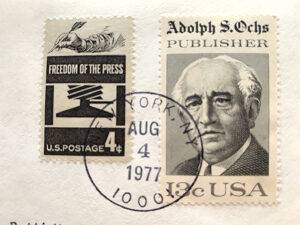 By Jon DeStefano
By Jon DeStefano It is amazing what treasures are waiting to be found in America’s great antique stores. A special thanks to Pine Emporium in Pine, Colorado, where we stumbled upon two volumes of the The Philatelic History of the United States, Volume 1 (1565-1806) and Volume 2 (1807-1866). We have added these treasures to our library.
The stamps which are featured with this article help us learn of the Peter Zenger Trial which occurred August 4, 1735 in New York, New York.
Peter Zenger was the publisher of the New York Weekly Journal, established in 1733 with the backing of a Chief Justice who had been unjustly dismissed by the corrupt British governor of New York. When the paper satirized the governor, he had Zenger arrested for criminal libel. The publisher was tried on August 4, 1735, and the defense was undertaken by a brilliant lawyer-friend of Benjamin Franklin. The “not guilty” verdict was a noteworthy step in affirming the doctrine of the freedom of the press in America.
The “Freedom of the Press” stamp, designed by Lester Beall and Frank Goslin, features a hand printing press, within a design resembling a type frame, and a hand holding a quill pen. The 13¢ stamp, designed by Bradbury Thompson, is based on a portrait by S.J Wolff.
In 1732 the British governor of New York, William Cosby, was one of the most corrupt in the colonies. Lecherous and unjust Cosby had managed to alienate everyone in New York except for the few sycophants who owed him their jobs. His greatest insult to the people, upon taking office, was to dismiss a much admired judge, Chief Justice Lewis Morris, and replace him with James de Lancey, the son of one of Cosby’s cronies.
Morris and his supporters sought redress. Since there was no legal course open to them, they turned to the press, and John Peter Zenger, a printer. In 1733, backed by Morris and with an accomplished young attorney named James Alexander as editor, Zenger began publication of a newspaper called the New York Weekly Journal, which was primarily designed to attack Cosby and his administration. Zenger, innocent of the political intrigues but anxious for the business, went along with his backers.
After one especially insulting satire, Cosby had Zenger arrested for criminal libel. Eventually, Zenger’s cause was taken up by the Sons of Liberty. In Philadelphia another printer, Benjamin Franklin, persuaded his friend and an eminent attorney, to take the case. Hamilton began the defense on August 4, 1735 by admitting the publication of the offending article. At that time such an admission was tantamount to a plea of guilty.
Then, with great court presence, he proceeded to sidestep Judge de Lancey completely. Hamilton took his case — the truth of the statements involved — directly to the jury. Electrified by their sudden importance in a Cosby court, the jury ignored the letter of the law and returned a verdict of “not guilty!” Visibly shaken, Cosby and de Lancey let the verdict stand. America had passed its first successful test of the doctrine of freedom of the press.















Follow Us